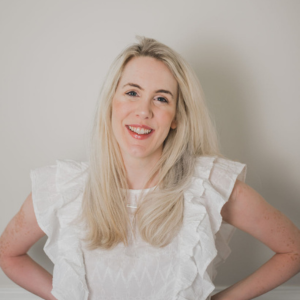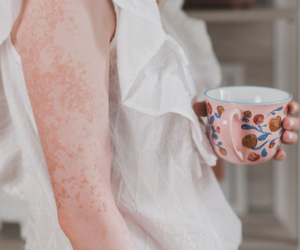Erika Page: Finding Purpose in Connection and Community
Erika Page is a fun-loving, compassionate mom of two. She also lives with vitiligo. And although she struggled significantly with the changes in her skin, she found a way to turn her pain into purpose by supporting others living with the autoimmune condition, and in turn, even helped herself.
“Finding a purpose in hard things can bring about healing. For me, that purpose was to create a website and blog that helped other people,” Erika said. “As it turns out, telling my story on Living Dappled really helped me. The power in my experience was the ability to both bring people together and bring people to me.”

Diagnosis
Much of Erika’s memories of her journey to diagnosis comes from her mom, as she was only 7 years old. From her perspective, she feels she’s had vitiligo her whole life. Vitiligo runs in her family (from her maternal grandmother) so her mom was familiar with the disease and took her to the dermatologist for an official diagnosis. Her first spots of pigment loss were on her spine, so she couldn’t see them. She remembers the disease became real to her when she began to see spots on her knees — reminding her every time she looked down that she was different from her peers.
Erika initially began an aggressive topical steroid treatment, but ultimately it didn’t work — her loss of pigment spread very quickly and the medication couldn’t keep up. And then there were the medication side effects — they cost a lot of money, time, and energy, and Erika chose not to pursue treatment. Despite how difficult her life with vitiligo was, she never regretted that decision; choosing to be a powerful advocate for herself from the beginning.
Growing up with vitiligo
Erika spent the first many years of her school life in the same place, with the same peers. They knew about her disease and accepted that she looked different but at the same time they knew she wasn’t any different than them. They were never surprised or unkind as her disease spread and she lost pigment in more places. At the end of middle school, Erika’s family started at a new school district. Not only did Erika have to get used to the school and the classes, but she had to make new friends. This was really difficult for her when she realized that this time, she felt different. She became the “spotted friend” and was very insecure in this new place. Erika said, “It’s hard to say if my new friends reacted to me in a certain way, or if it was my anticipation of how they would react to me, but it was a really big battle. I hated my skin and how I looked.”
At this time, Erika’s experience with her skin started impacting even day-to-day moments, like getting dressed or meeting new people. And although friends and family were encouraging and supportive, the positive affirmations offered by them felt so different from Erika’s experience that she felt misunderstood and alone.
“It’s very hard to wrap your mind around vitiligo,” Erika said. “There’s really nobody who understands the impossible notion of losing more pigment day after day except someone who is experiencing or has experienced it. This is why for a disease like vitiligo, community is so important.”
Living Dappled
When Erika was in her early 20s, one morning she was trying to get dressed and nothing looked or felt right. Through her sobbing, she realized it wasn’t the clothes she was frustrated with; she was frustrated with her body and with the thought that she was going to live with this condition for the rest of her life. In this breakthrough moment, the fairytale that her pigment might come back and she could find herself looking and feeling “normal” again was lost, and she was beside herself.
She began looking for ways to make it better. She started Googling vitiligo, and didn’t find a lot beyond heavy, clinical information about the disease and treatment; not anything about living with the disease and making it bearable. She decided at that moment to create an online support system where vitiligo patients could connect and talk about day-to-day things, filling a huge gap in resources. Living Dappled was born in 2016, serving as a place for women living with vitiligo to come together, share their stories, and talk about daily life with the disease.

The blog has grown into an incredible community. It’s a niche place, but it’s a safe place where vitiligo patients, parents, caregivers, and advocates can find support and know they’re not alone.
For Erika, it’s the little moments. It’s hearing about a ballerina who was so ashamed of her skin, she had never let it be seen. Then, through the support and inspiration she found at Living Dappled, this ballerina felt empowered enough to have her face, where she experienced the most pigment loss, photographed. It’s stories like these that are so needed for vitiligo patients to know they’re not alone.
Vitiligo for Life
Erika’s recommendation to new vitiligo patients: Do something positive. Something that makes you feel better. It can be as simple as using social media (e.g., Instagram or The Mighty) and searching the hashtag for your condition, joining in-person or virtual support groups – anything that helps you understand that within your disease community, your experience is normal and that others relate intimately to what you’re experiencing. Erika has found this to be critical to recognizing her experience, processing it, and moving through that.
There are also ways to get involved in person with your community – like hosting walks to raise money for vitiligo research or going to conferences like World Vitiligo Day to meet other people. It can also be as simple as wearing a vitiligo shirt or sticker. There are many ways to choose to identify your disease and find others like you. The power comes from finding community, giving your voice to your community, and giving a voice to yourself at the same time.
Life for Erika
At this point in Erika’s journey, she has no pigment in her skin remaining, and her day-to-day concerns are less about dealing with people staring at her or the outward journey, but more about taking care of her body: using more sunscreen and navigating pigment lost in her hair, eyebrows and eyelashes. And as a mom of two little girls, she is trying to turn her fears about their genetic predisposition to vitiligo into a reminder of how much awareness and acceptance exists now. Erika knows if either or both of her daughters were to get vitiligo, their experience would be so different than hers.
Erika’s final message is a powerful one:
“I wanted to create the blog that I would’ve wanted growing up “alone” with vitiligo. It’s inspiring to think that I could be creating and maintaining something that one day my kids might need, want, and use as well.”
Join Erika and others in the vitiligo community at livingdappled.com.
Join our email list
Receive the latest blog articles, news, and more right to your inbox!
Related articles you might be interested in

Raising Hope: Tim Lillis





Raising Hope: Amanda Jackson





Get Involved During Autoimmune Awareness Month





Meet Katherine Paglione: Integrating Work Life and Chronic Illness
Find more resources on autoimmunity
Learn more about autoimmunity, diagnosis tips, how to find a physician, and more.